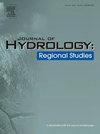自动化地表水分配系统在节能农业中的作用:伊朗中部干旱高原案例研究
IF 5
2区 地球科学
Q1 WATER RESOURCES
引用次数: 0
摘要
研究区域伊朗中部的内库阿巴德灌区因地表水分配效率低下而面临挑战。每年从 15,000 口管井中抽取 8,200 万立方米地下水,导致地下水位下降,能源消耗每年增加 2.34 亿千瓦时。采用水力模拟模型和集中模型预测控制方法对现有系统进行分析,并提出恢复计划。结果表明,引入自动化可显著改善地表水分配,从而减少地下水的过度开采,进而节约能源,尤其是在缺水时期。在正常情况下,缺水量低于 10%、10-15% 和 15-20% 时,节能率分别提高了 42.3%、54.8%、56.2% 和 57.7%。然而,随着地表水短缺的加剧,正常情况下的节能率分别下降到 57.7 %、43.7 %、25.4 % 和 18.9 %,缺水率分别为 15-20 %、20-30 %、30-40 % 和 40 % 以上。自动化的引入有效地提供了可靠的地表水资源,促使农民关闭泵站或减少工作时间。即使在极端情况下,该项目也实现了高达 18.9% 的能源节约。本文章由计算机程序翻译,如有差异,请以英文原文为准。
The role of automated surface water distribution systems in energy-saving agriculture: A case study from central Iran’s Arid Plateau
Study region
The NekooAbad Irrigation District in central Iran faces challenges due to inefficient surface water distribution. 82 million m3 of groundwater is extracted annually from 15,000 tube-wells, leading to decreased groundwater levels and increased energy consumption of 234 million kWh per year.
Study focus
This study explores implementing automation in surface water distribution to reduce groundwater extraction and conserve energy. A hydraulic simulation model and a centralized Model Predictive Control approach were used to analyze the existing system and propose a recovery plan. The potential impact of automated surface water distribution on reducing groundwater extraction and energy conservation was evaluated through spatial assessment in GIS.
New hydrological insights for the region
The results demonstrate that the introduction of automation can significantly improve surface water distribution and, accordingly, groundwater overexploitation and, consequently, energy conservation, particularly during water scarcity. Energy conservation increased by 42.3 %, 54.8 %, 56.2 %, and 57.7 % under normal conditions, with water shortages of less than 10 %, 10–15 %, and 15–20 %, respectively. However, as the surface water shortages intensified, the energy conservation rates decreased to 57.7 %, 43.7 %, 25.4 %, and 18.9 % for normal conditions, water shortages of 15–20 %, 20–30 %, 30–40 %, and over 40 %, respectively. The automation introduction effectively provided reliable surface water resources, prompting farmers to shut down pumping stations or reduce working hours. Even in extreme scenarios, the project achieved up to 18.9 % energy savings.
求助全文
通过发布文献求助,成功后即可免费获取论文全文。
去求助
来源期刊

Journal of Hydrology-Regional Studies
Earth and Planetary Sciences-Earth and Planetary Sciences (miscellaneous)
CiteScore
6.70
自引率
8.50%
发文量
284
审稿时长
60 days
期刊介绍:
Journal of Hydrology: Regional Studies publishes original research papers enhancing the science of hydrology and aiming at region-specific problems, past and future conditions, analysis, review and solutions. The journal particularly welcomes research papers that deliver new insights into region-specific hydrological processes and responses to changing conditions, as well as contributions that incorporate interdisciplinarity and translational science.
 求助内容:
求助内容: 应助结果提醒方式:
应助结果提醒方式:


